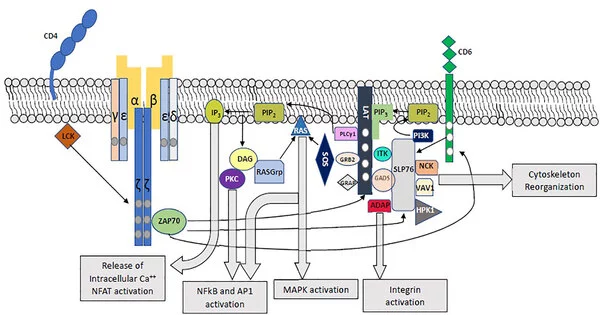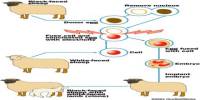Signal transducing adaptor proteins (STAPs) are proteins that function as auxiliary proteins in a signal transduction pathway. It is essential for signal transmission within cells. Adaptor proteins contain a number of protein-binding modules that connect protein-binding partners and allow for the formation of larger signaling complexes. They serve as bridges between cell surface receptors and intracellular signaling pathways, allowing information to be transmitted from the extracellular environment to the cell’s interior.
These proteins typically lack intrinsic enzymatic activity, instead mediating specific protein-protein interactions that drive protein complex formation. MYD88, Grb2, and SHC1 are examples of adaptor proteins. These proteins participate in a variety of cellular processes, including cell growth, differentiation, survival, and response to environmental cues.
Signaling components
The recruitment of several signaling components, such as protein kinases and G-protein GTPases, into short-lived active complexes in response to an activating signal, such as a growth factor binding to its receptor, accounts for much of the specificity of signal transduction.
Here are some key points about signal transducing adaptor proteins:
- Function: Adaptor proteins act as go-betweens for cell surface receptors and downstream signaling components. They do not have enzymatic activity and instead act as scaffolds for the assembly of signaling complexes.
- Structure: Adaptor proteins have modular structures with specific domains that allow them to interact with other proteins. Src homology 2 (SH2), Src homology 3 (SH3), and phosphotyrosine-binding (PTB) domains are all common domains that allow proteins to bind to phosphorylated tyrosine residues on other proteins.
- Binding to Receptors: Adaptor proteins often bind to activated receptors through their specific domains. For example, SH2 domains recognize and bind to phosphotyrosine residues on activated receptors, initiating the formation of signaling complexes.
- Signal Amplification: Adaptor proteins contribute to signal amplification by recruiting multiple signaling molecules to the receptor complex. This clustering of signaling components enhances the efficiency and specificity of signal transduction.
Examples of Adaptor Proteins:
- Grb2 (Growth factor receptor-bound protein 2): It is a well-known adaptor protein involved in the Ras-MAPK signaling pathway. Grb2 contains an SH2 domain that binds to phosphorylated tyrosine residues on receptors and an SH3 domain that interacts with downstream signaling molecules.
- Shc (Src homology and collagen): Shc is another adaptor protein that is involved in a variety of signaling pathways. It has several domains, one of which is an SH2 domain that binds to phosphorylated tyrosine residues.
- LAT (Linker for Activation of T cells): LAT is a signaling adaptor protein that is essential in immune cells, particularly T cells. It is essential for T cell receptor (TCR) signaling.
- Disease Implications: Adaptor protein dysregulation has been linked to a variety of diseases, including cancer and autoimmune disorders. Uncontrolled cell growth or inappropriate immune responses may result from abnormal signaling via adaptor proteins.
Understanding the roles of signal transducing adaptor proteins is critical for deciphering the complexities of cell signaling and developing targeted therapies for diseases characterized by dysregulated signaling pathways.
















